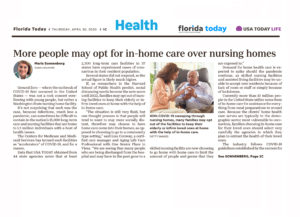 Ground Zero — where the outbreak of COVID-19 first occurred in the United States — was not a rock concert overflowing with young people, but rather a Washington State nursing home facility.
Ground Zero — where the outbreak of COVID-19 first occurred in the United States — was not a rock concert overflowing with young people, but rather a Washington State nursing home facility.
It’s not surprising that such was the case, because infections, much less a pandemic, can sometimes be difficult to contain in the nation’s 15,000 long-term care and nursing facilities that are home to 1.3 million individuals with a host of health issues.
The Centers for Medicare and Medicaid Services has termed such facilities as “accelerators” of COVID-19, and for a reason.
Data that USA TODAY obtained from 44 state agencies notes that at least 2,300 long-term care facilities in 37 states have experienced cases of coronavirus in their resident population.
Several states did not respond, so the actual figure is likely much higher.
If, as researchers in the Harvard School of Public Health predict, social distancing needs become the new norm until 2022, families may opt out of nursing facilities to keep their elderly or infirm loved ones at home with the help of in-home care.
Demand for home health care is expected to spike should the pandemic continue, as skilled nursing facilities and assisted living facilities may be unable to accept new residents because of lack of room or staff or simply because of lockdowns.
Currently more than 10 million people in the United State utilize some form of in-home care for assistance for everything from meal preparations to wound care. Because the clients’ home health care serves are typically in the demographic sector most vulnerable to coronavirus, families choosing in-home care for their loved ones should select very carefully the agencies to which they plan to entrust the health of their loved ones.
The industry follows COVID-19 guidelines established by the centers for Disease Control and Prevention.
Professional caregivers must ensure client safety by wearing masks, gloves and other protective gear and following protocols for monitoring their own health.
Anyone considering in-home care should inquire about what protective measures are in place and check that the caregivers are indeed following these procedures.
While in theory home care can be a viable option in the age of coronavirus, it can be a difficult pill to swallow for some clients, even in the best of times.
“One of the things that I often hear from clients and families as I am in their homes doing an assessment is that it is hard to have a stranger come into their home and help with things that they are used to doing for themselves,” said Conway. “They may not only feel a loss of control, but also feel as if no one else can do things the way that they can.”
John Barrett, 88, widowed in 2010, moved to an over-55 community in Brevard in 2011 based on the suggestion of a friend.
“He had no family in Florida and I was immediately concerned, (but) he made it clear that he was capable of living independently and was adamant he needed no assistance whatsoever,” said his daughter, Freehold Township, New Jersey, resident Shelly Campbell.
Later in the year, Campbell’s dad fell and was hospitalized.
“Upon his discharge he was reluctantly agreeable to have in-home care while he recovered,” she said.
One of her father’s neighbors recommended One Senior Place. Here, Campbell was able to schedule in-home care for her dad for 12 hours a week, an arrangement that remained flexible according to Barrett’s needs.
“As his health deteriorated over the past several years, his care manager was able to coordinate 24-hour in-home care,” Campbell said. “My concern was for my father’s well-being and that he be matched with home health care aides that wouldn’t be intimidated by his sometimes difficult and demanding behaviors.”
Conway, of One Senior Place, says her agency tries to match caregivers who are compatible with the personality and interests of individual clients, a critical component of successful in-home care.
Although aging in place is a goal most people would prefer, the in-home care needed to permit individuals to remain at home has drawbacks, primarily the risk of too much social distancing, aka isolation, if the caregiver does not actively encourage the client to connect with others.
The stay-at-home order has increased the problem. Home care staff have doubled efforts to help clients stay connected, at least virtually, with family and friends who are not able to visit in person.
Professional caregivers can assist clients in connecting with family members through video chat options such as Face Time for Apple devices and Zoom for androids. Caregiver collaboration app Outpatient can help families interact with caregivers to get the latest information on the client.
Campbell believes in-home care can be extremely helpful with issues of social isolation.
“A compatible caregiver is great company,” she said.


